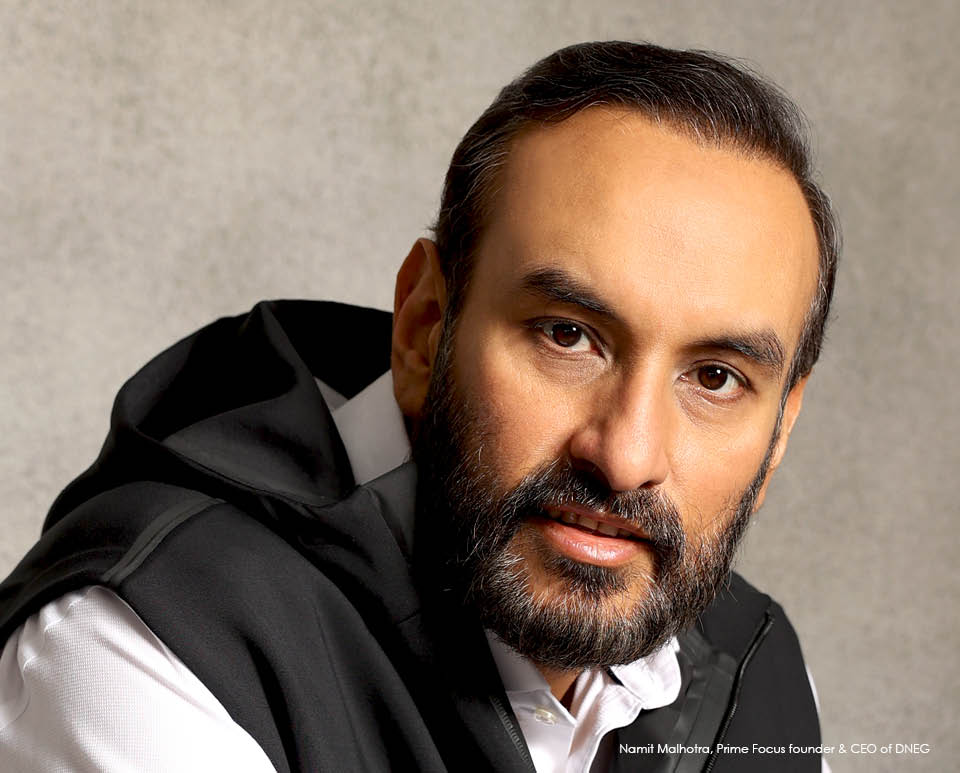
Creatively and technologically, Namit Malhotra is part of a movement [re]moving filmmaking barriers between East and West.
Namit Malhotra is part of a movement that will, if it succeeds, create Indian films with global aesthetics and narrative forms. “Whether we succeed or fail, the jury is out. But we are leaving no stone unturned to reach there,” says the Prime Focus founder and CEO of DNEG, which has won seven Academy Awards for, among others, Dune and Tenet. Vanita Kohli-Khandekar spoke to him about the relationship between technology and storytelling in the era of spectacle films, and India’s filmmaking evolution as budgets rise with consumers’ growing appetites.
Where in the global film/media ecosystem does DNEG/Prime Focus sit? For the last 25-30 years, our focus has been the building of the largest and most integrated company in the world, which is what Prime Focus/DNEG is today. It is in terms of revenue (US$508 million), headcount (10,000), number of Oscar awards (7) in the last 10 years, global locations (London, India, Canada, etc) the most diversified.
What part did DNEG play in the success of say "Dune" or "Kalki 2898 AD"? In "Interstellar", the director’s (Christopher Nolan) vision is that we show the world what happens when you travel through time and space through the wormhole or blackhole. There is no evidence of what that means in the real world, no imagery. We worked with Nobel prize winning theoretical physicist, Kip Thorne, and used his scientific formulae to render something that scientific journals said was ‘as accurate as it gets’. A filmmaker of the ilk of Chris Nolan, his vision has always been about doing something unique. It cannot just be great, snazzy images. He wants to make the audience experience that reality on the big screen. We work closely with these filmmakers (like Denis Villeneuve of Dune or Nolan) to make that impact. That is where our technology and creative skill set comes into action.
Does it ever stop becoming about the story and more about the visual effects? Does VFX overpower the story at times? No technology, no tool, no superstar means anything. What people care about ultimately is the story they are be...
Creatively and technologically, Namit Malhotra is part of a movement [re]moving filmmaking barriers between East and West.
Namit Malhotra is part of a movement that will, if it succeeds, create Indian films with global aesthetics and narrative forms. “Whether we succeed or fail, the jury is out. But we are leaving no stone unturned to reach there,” says the Prime Focus founder and CEO of DNEG, which has won seven Academy Awards for, among others, Dune and Tenet. Vanita Kohli-Khandekar spoke to him about the relationship between technology and storytelling in the era of spectacle films, and India’s filmmaking evolution as budgets rise with consumers’ growing appetites.
Where in the global film/media ecosystem does DNEG/Prime Focus sit? For the last 25-30 years, our focus has been the building of the largest and most integrated company in the world, which is what Prime Focus/DNEG is today. It is in terms of revenue (US$508 million), headcount (10,000), number of Oscar awards (7) in the last 10 years, global locations (London, India, Canada, etc) the most diversified.
What part did DNEG play in the success of say "Dune" or "Kalki 2898 AD"? In "Interstellar", the director’s (Christopher Nolan) vision is that we show the world what happens when you travel through time and space through the wormhole or blackhole. There is no evidence of what that means in the real world, no imagery. We worked with Nobel prize winning theoretical physicist, Kip Thorne, and used his scientific formulae to render something that scientific journals said was ‘as accurate as it gets’. A filmmaker of the ilk of Chris Nolan, his vision has always been about doing something unique. It cannot just be great, snazzy images. He wants to make the audience experience that reality on the big screen. We work closely with these filmmakers (like Denis Villeneuve of Dune or Nolan) to make that impact. That is where our technology and creative skill set comes into action.
Does it ever stop becoming about the story and more about the visual effects? Does VFX overpower the story at times? No technology, no tool, no superstar means anything. What people care about ultimately is the story they are being told. That is the crux of what we do. If the director wants to tell you a story about going into time and space through the blackhole and wormhole, he cannot tell that story if he does not use the tool to show you that. It is servicing the need of the story and not the other way round. There are instances in world of filmmaking where people think it is cool, that young people will love it, let us style it, design it so that people get the wow impact. That happens. At that point we put on that hat to deliver that part of the storytelling they want to achieve. You have to think of us as designers, we are custom creative creators. Ultimately even if I think it too much, if that is what they want, then that is what they will get.
If "Dune" and "Interstellar" are the pinnacle of the high-end work, is there middle and lower end, bread and butter stuff that is different? We don’t call it bread and butter. Just because we win an Oscar, doesn’t make it everything. We have done films like "First Man" or "Ex Machina", which are very small budget but Oscar-worthy movies. But these are not big enough to keep a company of our size fed. So we will still do some of the biggest visual effects extravaganzas that are made. Ultimately, an Oscar is a qualitative call by the Academy. But whether we are doing "Fast and Furious" or "Dark Knight", for us sometimes the other work is harder, more complex. "Ex Machina" is the lowest budget Oscar-winning (for visual effects) movie in the history of the business.
You are getting into production now with "Garfield" and "Ramayana". Does it create conflict with clients? We have produced films but in a more fragmented manner. We started an animation division seven to eight years ago and made "Garfield" (released in 2024) and "Angry Birds 3" (in production). We co-produced "Brahmastra" – part one, Shiva (the first of an Indian trilogy, 2022). The idea now is do it in a more structured manner. How do we become a source where filmmakers can say ‘hey let me go to Prime Focus, they can help me bring my project to life’. "Ramayana" is funded and created by us, it will be directed by Nitesh Tiwari (the director of "Dangal", the biggest Indian blockbuster of all time). The vision, scale and ambition of making it happen comes from me. I believe that the world should sit up and watch it. It is the biggest production currently in the world with two parts going back-to-back.
How did "Brahmastra" happen? Ayan (Mukherji, the director) was clear ‘I want you not just as a VFX company telling me how to do it but take some responsibility in delivering that’. I came on board more as a creative producer to fit the director’s vision. Then, we also take a financial position because we were going beyond the scope of just being a vendor. That is why the idea of becoming more invested is interesting. With "Ramayana", which we are producing, we are trying to tell an Indian subject but for the world. Why would this be anything less than say Lord of the Rings or Avatar. Am also trying to build parity – different films perform differently, audiences have different tastes. But creatively and technologically we are removing the barriers between East and West.
Isn’t that imperative given the audience is homogenised. We are all exposed to the same level of storytelling thanks to streaming. But the revenue outcome for a "Brahmastra", which gets the bulk of its revenue from India, versus "Oppenheimer", which gets roughly half its revenues from the U.S., are different…. It is a bit of a chicken and egg. Unless you make that breakthrough the world can consume, you will never get there. It is time for Indian filmmakers and filmmaking to get to a place we present something aesthetically and at a scale and in a narrative form that the world can consume. Whether we succeed or fail, the jury is out. But we are leaving no stone unturned to reach there.
Indian cinema is a wonderful space. But does it offer enough opportunities to do the kind of work you do in Hollywood? Everything that we price is based on how much time and effort is going to be applied to doing the work. So Brahmastra or Kalki will be priced based on the complexity of what is being asked. And how much use of the talent needs to be made internationally; we do know talent in the West is going to be more expensive than talent in East. We are upfront with the filmmaker on how much time and resources are going to be applied based on the budget they have. The world of filmmaking in India or the West is becoming similar. The reason to go to a cinema today is for to a big event – like Kalki. Munjya (a horror comedy), which is doing so well is also a Prime Focus delivery. You can see the transition; budgets in India are growing as the appetite of our consumers becomes similar to the rest of the world. Kids today consume a Marvel movie or a Western movie in the same way that they consume an Indian movie. The games they play, the clothes they wear, everything is becoming much more homogenised. That is the customer we are servicing.




























